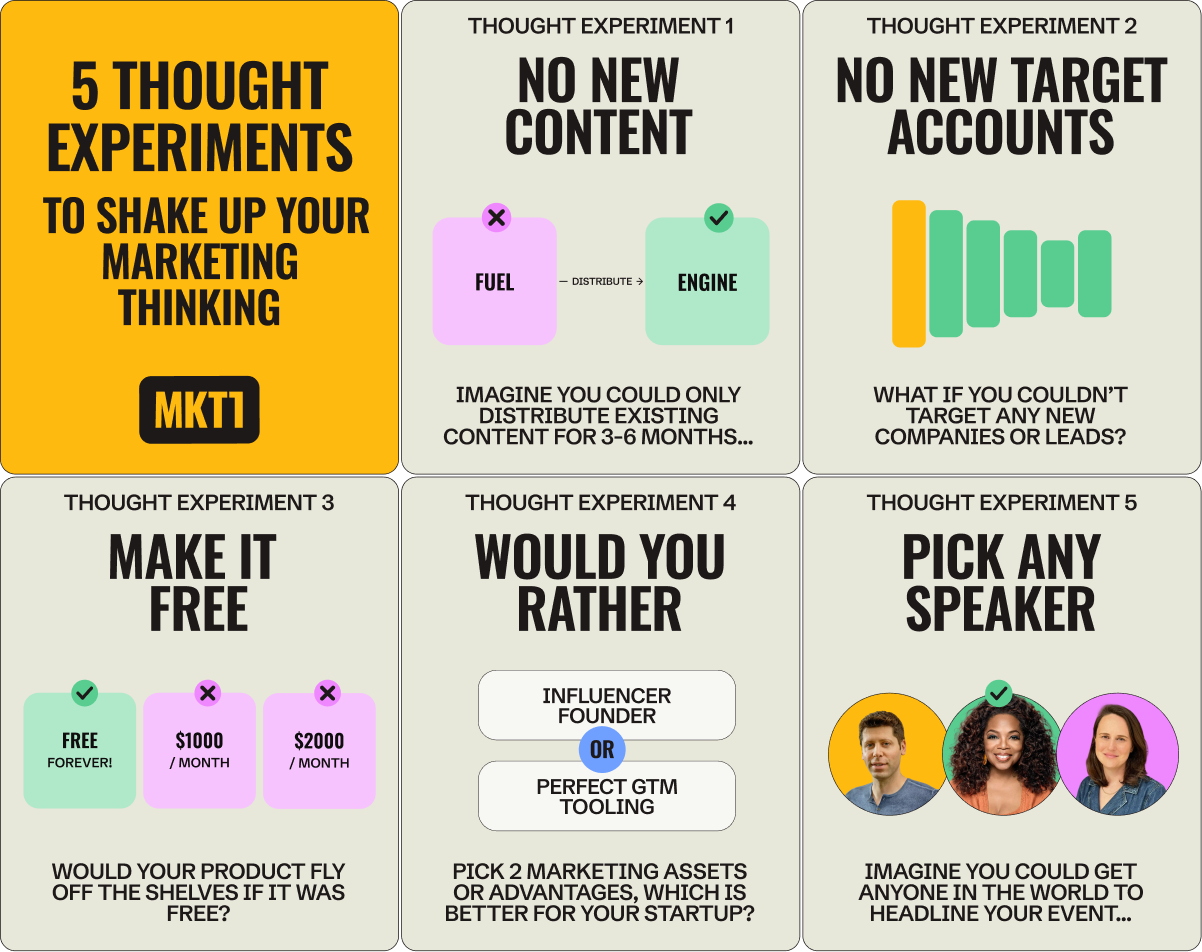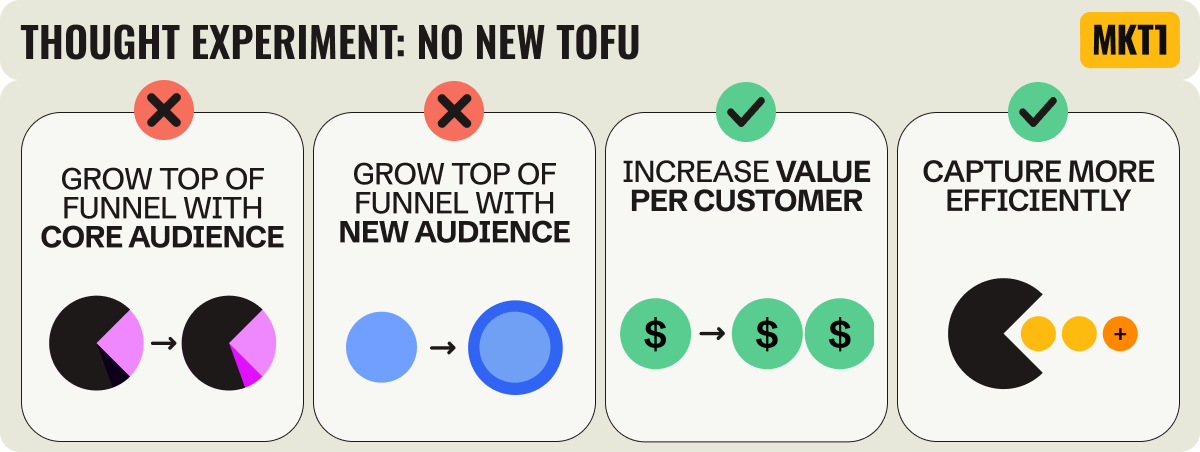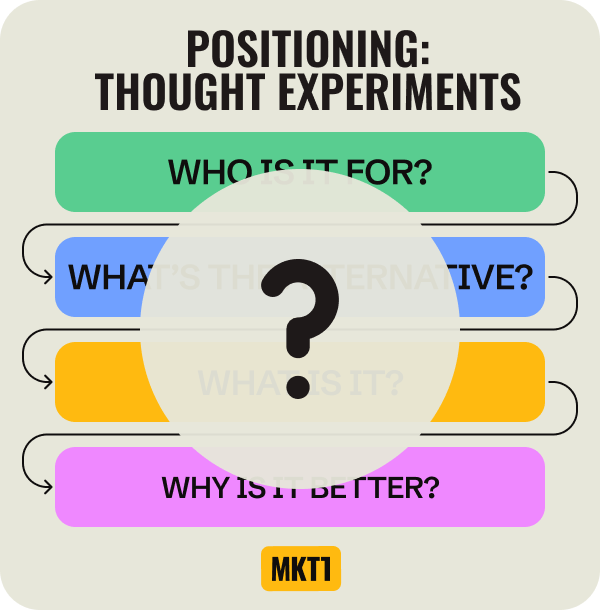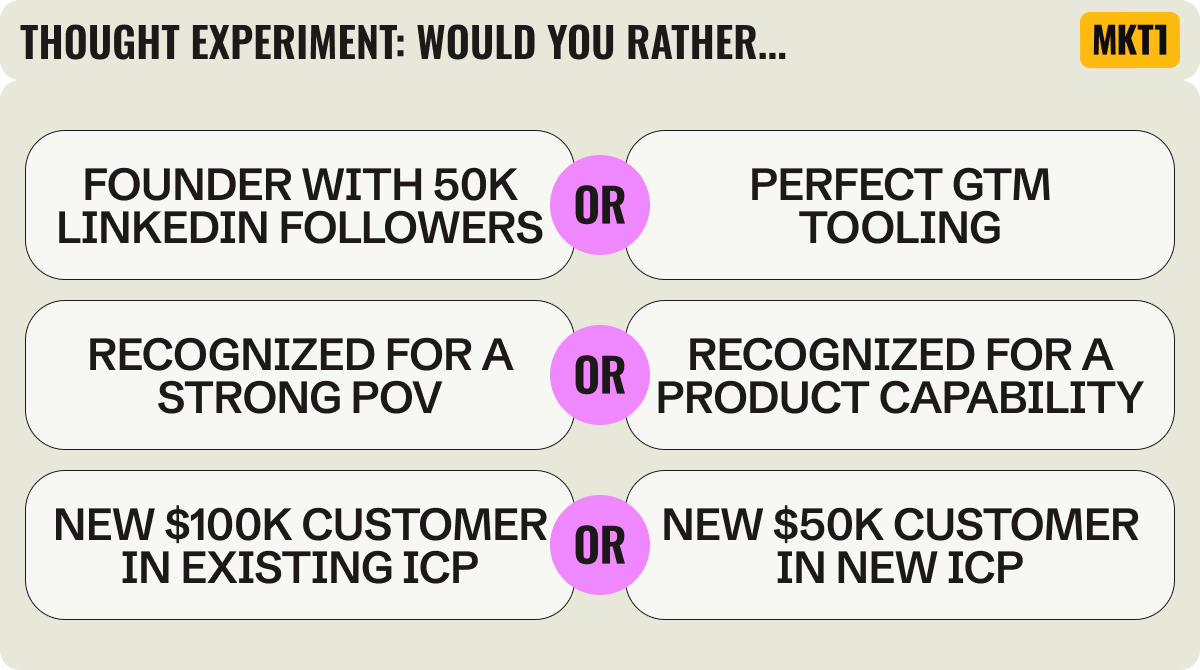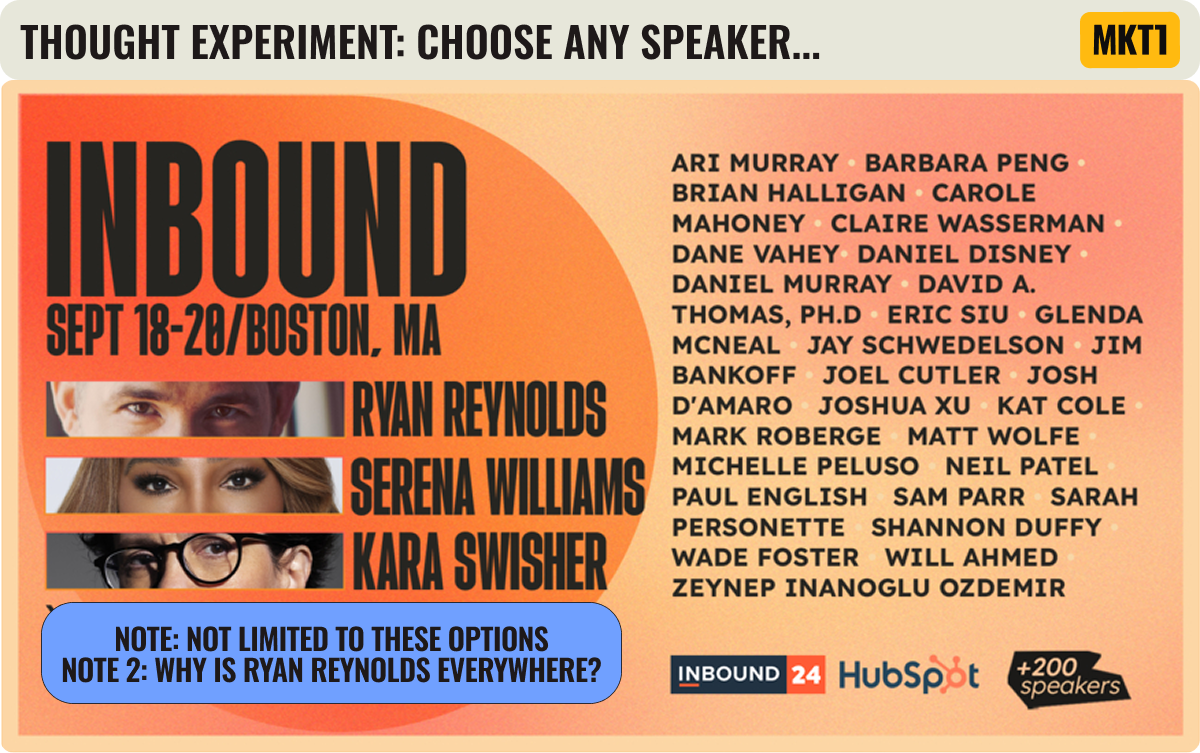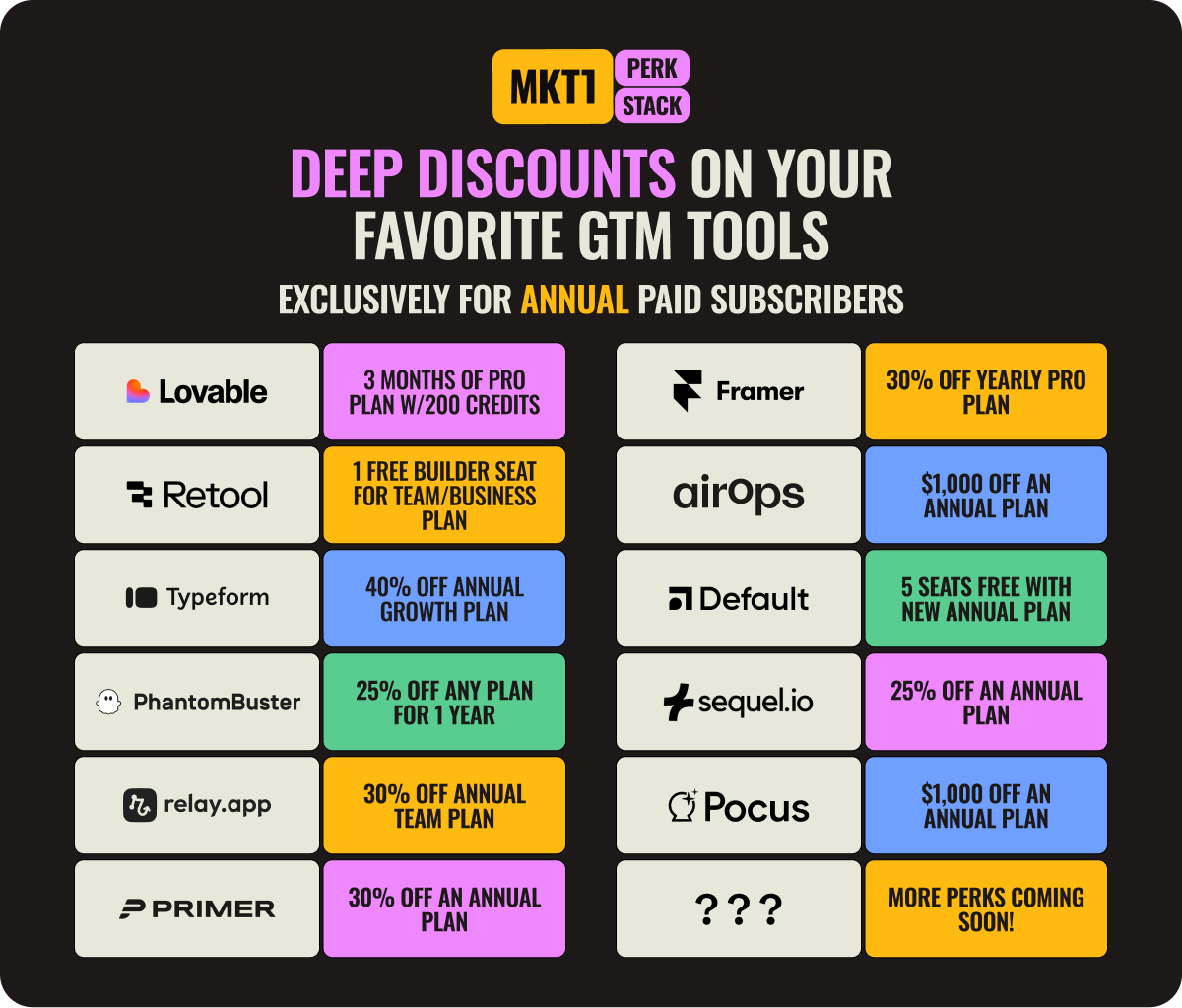How to get unstuck: 5 marketing planning thought experiments
An atypical set of prompts to help you shake up your marketing thinking
👋 This is a monthly free edition of MKT1 Newsletter—a deep dive into a B2B startup marketing topic, brought to you by Default, Luma AI, and 42 Agency.
Upgrade to a paid subscription for: Gen Marketer Summit | 100+ templates & resources | MKT1 Job Board - Free Posts | MKT1 Archive access | New MKT1 Perk Stack, exclusive discounts worth $40K+ for annual paid subscribers.
This past week I’ve been spinning on newsletter topics. Staring at a list of ideas, starting to write, backtracking, scrapping paragraphs, rewriting them again. Nothing felt quite right.
And honestly, that feels like the default state of marketing right now.
We’re all scrambling to break the mold and stand out. We’re overwhelmed by everything we could do, yet underwhelmed by the results of what we are getting.
Then it hit me: The best follow-up to my recent annual planning newsletter isn’t more prioritization frameworks or more structure. It’s the opposite. Whenever I’m advising marketers, the biggest breakthroughs come from thought experiments: hypothetical exercises with a few intentional constraints. These conversations force new ideas to the surface and bend your brain just enough to reveal ideas that might actually work.
So this newsletter shares 5 of my go-to thought experiments. Simple, occasionally uncomfortable prompts to jolt you out of the rut and help you rethink your 2025 strategy with a fresh, more creative brain.
Recommended products & agencies
We only include sponsors we’d recommend personally to our community. If you are interested in sponsoring our newsletter, email us at sponsorships@mkt1.co.
➜ Default puts scheduling, routing, and enrichment in one platform, so the data in your CRM stays clean and you can orchestrate GTM 10x better. Plus, it’s used by startups like Replit, Profound, Unify, JustWorks, and Decagon.
Offers:
🎁 All subscribers: Mention MKT1 to get 2 months free on any plan for up to 10 seats ($1500+ value)
🔒MKT1 Perk Stack offer for Annual paid subscribers: Get 5 seats free + 1 year of free intent data. Redeem here.
__
➜ Luma AI: Before you outsource your next video production, try Luma AI’s Dream Machine, an AI-powered video generation platform. Start with text, an image, or another video to produce and edit on-brand, cinematic-quality content in minutes.
See more: Luma AI is featured in today’s Unboxing video!
🎁 Offer: Mention MKT1 to get 20% off an Enterprise Essentials plan.
__
➜ 42 Agency: Let 42 Agency handle the MOPS work your team avoids. From routing logic and fixing scoring, to aligning Hubspot + Salesforce, to setting up new GTM tooling, 42 Agency is ready to help your B2B startup clean up and scale your ops.
🎁 Offer: Mention MKT1 to get 10% off a Hubspot Audit or Hubspot Sprint.
In this newsletter:
5 thought experiments and how to run them:
No new content
No new target accounts
Positioning stress tests
Would you rather
Pick your dream speaker
More from MKT1:
I unbox Luma AI in our 2nd video in our new Unboxing series, which helps you discover new GTM tools
Gen Marketer Summit: Registration is open for our first-ever virtual conference! We’ve announced the first wave of speakers, more coming soon. Free for all paid subscribers.
MKT1 Perk Stack: Exclusive discounts worth $40K+ on our favorite GTM tools (like Lovable, AirOps, Framer, Default, and more). For annual & superfan paid subscribers only.
Thought experiment newsletter
Use these when you’re stuck, overwhelmed, or circling the same ideas during planning. Thought experiments work because they drop you into a constraint that forces new thinking. Pick a prompt, treat the constraint as real, and follow it through with hypothetical examples to see where the discussion goes. The goal isn’t to “solve” anything; it’s to shake you out of your defaults, surface blind spots, and make you see things from a new angle.
THOUGHT EXPERIMENT 1
No new content
To start, here’s one of my favorite questions to ask startup marketing teams to get them out of their comfort zones. I first shared this thought experiment in a series on my own content strategy.
The prompt
What if you weren’t allowed to create any net-new content for the next quarter, or even six months? In this hypothetical, you can reuse things you have and modify things slightly for new channels, but you must grow by distributing existing assets. What would you do? Do you think this would help or hurt your ability to hit your KPIs?
Why this experiment
If you are over-indexing on creating “fuel” and under-indexing on building an “engine” to distribute, this thought experiment will help you recalibrate.
Teams default to creating new things instead of deepening and compounding what already works. They set content goals around volume (i.e. “15 new pieces of content a month”), but never meaningfully distribute that content.
The best ideas may just be extensions of things you’ve already created. More ROI may come from redistributing things you already have (aka getting more mileage). This experiment exposes how much growth is trapped inside your existing content.
Consider this..
What would happen if distribution—not creation—became your focus for a whole quarter?
Which pieces of existing content have never been fully distributed?
What would happen if you “franchised” your best ideas? What could become a series or workshop?
What content is outdated but fixable?
What 5–10 existing pieces, if improved, would outperform anything net-new?
Which assets should have driven a key KPI but didn’t? Would distributing or repackaging help?
What content types perform best channel by channel, and could these be extended or tweaked to serve other ICPs and/or work on other channels?
THOUGHT EXPERIMENT 2
No new “top of funnel”
This thought experiment is similar to the first one—it forces you to give something up, but this time the constraint is where you focus your growth efforts.
The prompt
What if you couldn’t target any new leads or accounts for the next 3–6 months? No new lists, no new audiences. Just re-engaging the people and companies who already know you. All of your effort goes into lifecycle, activation, upsell, and recycling campaigns (levers 3 and 4 in the above image).
Why this experiment
If you’ve been focused heavily on top-of-funnel without any lifecycle marketing efforts, funnel conversion rate experiments, or efforts to drive up value per customer, you’re likely throwing money (and leads) away. Many startups keep pushing new audience growth—even when they’ve saturated their target accounts and leads with outbound sequences and ads—because it feels scary to take your foot off the gas.
But remember: there are four primary Revenue Levers™ for growth (see image above), and marketing should pull all of them—not just the first two. Teams often over-invest in acquisition and awareness while under-investing in efficiency and expansion, where some of the highest-ROI improvements actually live.
On the flip side, this exercise might also reveal that you’ve already saturated or “juiced” your current audience to the point where even major efficiency gains or upsell efforts won’t move the needle. If that’s the case, the takeaway isn’t to do more lifecycle work—it’s that you’ve likely hit the ceiling on your existing ICPs and it’s time to explore new segments.
Consider this…
Could you layer in a new channel—LinkedIn DMs, custom events, ecosystem and partnerships, or warm outbound—to reach accounts and leads stuck mid-funnel?
If you hired a dedicated person (or 2) to focus on lifecycle marketing right now, what would their top projects be?
Which lifecycle moments have the lowest lift and the highest potential return?
Where in the lifecycle (from qualified leads or accounts to expansion) would they focus first?
What work could be done to re-engage recycled leads or accounts—and how many are there?
Do you have retargeting campaigns set up for these audiences?
Are you tracking “signals” not just from active companies and leads, but from these segments too?
Are you planning to launch new features that could help you win companies you previously lost? And are loss reasons/feature gaps tagged in your CRM so you’re ready?
Could you increase the average contract value by helping drive upsell, cross-sell, or purchases of a more expensive plan? What’s the first thing you would do here?
How could you improve conversion rates from 10–20% at each lifecycle stage (recognizing that doing this all at once is hard!)?
You can use our new free forecasting tool to see what the impact of all of these efforts might be!
THOUGHT EXPERIMENT 3A & 3B
Differentiation stress tests
These two thought experiments force you to get real about your positioning, product marketing, and storytelling efforts. You can choose just one, or run both back-to-back.
They expose the uncomfortable truth most teams avoid: whether your differentiation is real, and whether your product is important enough for people to make space for it.
These initially might seem like thought experiments that product should be running, but actually they reveal a ton about marketing’s efforts. They give you a new lens to evaluate your product marketing and brand marketing efforts, other than simply saying, “we think we need to redo positioning.”
Prompt A: Overnight copycat
If a competitor copied your product overnight—feature for feature—why would a buyer still choose you?
Why this experiment
If a feature-for-feature product clone could replace you, you don’t have a brand moat. Marketing needs to make the case for stronger narrative, positioning, and brand-building.
I saw this firsthand at Asana a decade ago, when Monday (then called DaPulse) showed up with a very similar product. If I could turn back time, we’d have been more prepared on the marketing side—even with a very strong brand.
Consider this…
If a competitor matched your product tomorrow, what would you do more of immediately to maintain your differentiation or POV?
What would you say about your company if you couldn’t talk about features or price at all?
Which parts of your brand, narrative, or experience are truly hard to copy—and which parts are dangerously easy?
Where are you relying too heavily on features to differentiate? How could marketing better differentiate via brand, content, etc.?
Prompt B: Make it free
If your product suddenly became completely free, would it be much easier to acquire customers? And if not, why not?
Why this experiment
If “free” wouldn’t meaningfully increase adoption, it may not be clear how you solve a real problem for your audience or are differentiated over other options.
Marketing may need to talk to their ICPs and articulate value more clearly—and not just by asking product for more features. Perceived value can come from storytelling, content, experiences, and credibility as much as from the product itself. For example, Clay has built up a network of GTM engineers who can help you implement the product and Lovable has built a 150K plus Discord community to support people in using the product.
Consider this…
If a free product wouldn’t drive up acquisition or adoption, what friction is actually blocking people (trust, clarity, switching cost, category confusion, etc.)?
What narratives, partnerships, customers, events, etc. best demonstrate your real value? Are you investing enough here?
Would this differ for different ICPs, why? Do certain segments understand the problems you solve and value you provide more than others? Which of these segments could you double down on?
Which elements of your positioning feel “true internally” but aren’t actually resonating in the market?
THOUGHT EXPERIMENT 4
Would you rather [x] or [y]?
This thought experiment might sound a bit silly, but it actually yields some of the most real-talk conversations.
The prompt
Force yourself (or your team) to pick between two strategic options. No “both,” no “it depends.” Just choose and explain why.
See examples in the consider this section below…
Bonus idea: Make it a game. Write various marketing outcomes (e.g., “2× ACV,” “founder gains 50,000 followers overnight,” “your dream integration partner says yes”) on cards. Flip two over and debate. This is honestly really fun at a team dinner or offsite.
Double bonus: These also make great interview questions. You’re not looking for one right answer; you’re looking for structured thinking, logic, and POV.
Why this experiment
Marketing is a constant series of tradeoffs, but most teams avoid making real choices—or try to do everything at once. This feels like the safer path, but instead, it leaves you with a bunch of random acts of marketing and limited impact.
By forcing a binary decision, you surface instincts, priorities, and your actual appetite for constraints vs. scale. It’s especially valuable with cross-functional leaders or your founder/CEO in the room (expect debate).
This exercise reveals:
Where you’re spreading yourself too thin
Which levers you actually believe could drive growth
Potential big bets or places to double down
Your implicit hierarchy of channels, content types, and motions
Where your team secretly disagrees (but hasn’t said it out loud)
Consider this..
Pick a few of these “Would you rather…” prompts, or mix and match, or create your own:
Have the perfect GTM tooling setup or a founder who is already an influencer? I asked this one on LinkedIn, see what people think…
Have no competitors right now or multiple competitors helping you build a new category or narrative?
Be known for a POV or a product capability?
Land a [$100K] customer in [existing ICP] or a [$50K] customer in a [new ICP]?
Partner with one major ecosystem player or activate 50 smaller creators?
Host one killer IRL event or publish 10 strong content pieces?
Double your ACV or double lead volume?
Get your product covered in a popular newsletter or get a glowing review from Gartner?
Have your competitor launch a terrible takedown ad about you, or have them completely ignore you forever?
THOUGHT EXPERIMENT 5
Pick a big-name speaker
This one is a take on “if you could have dinner with anyone in the world…who would it be…”—but applied to a business event.
The prompt
You’re hosting a major event. You can have any speaker in the world represent your company at no cost. Who would it be? Why? What would they say?
You can also blow this out into a full-day conference. If every dream speaker said yes and charged nothing, what would your agenda be?
Why this experiment
This exercise helps you dream really big on what story you want to tell, and who you could tell it best. When you force yourself to choose anyone in the world, you surface the clearest version of the narrative you wish your brand owned.
After you dream big (“We pick Oprah!”), come back down to earth. Use the energy and creativity to answer planning questions: “What Perception are we actually trying to drive? And who is a realistic, credible partner who can help reinforce it?”
Perceptions™ are the key narratives you want to drive in your market. They are written from the perspective of your audience and are the foundational tenets of your story.
An ecosystem strategy can accelerate your narrative and growth by piggybacking on the credibility and reach of partners. I just wrote about ecosystem growth in Lenny’s newsletter, read it here!
Consider this..
Are you more interested in the speaker’s reach or their narrative? Will they help more with fuel or engine?
What Perception would they reinforce about your company, and is that the Perception you actually want to drive this year?
Who would they get in the room? What could you do to get those same people “in the room” without this spokesperson?
What would this person say that you can’t currently say? And what would it take to build a brand where your CEO could give that talk?
Is there a more realistic speaker (a niche expert, creator, partner, or customer) who could deliver a similar narrative to a smaller but more relevant audience?
Does this reveal an ecosystem strategy you should explore?
What ideas, storylines, or themes showed up in your answers? Should any of those become formal Perceptions or narratives you aren’t telling right now?
Bonus: More thought experiment ideas
1 KPI only
Prompt: If your dashboard broke and you could only track one KPI all year, what would it be?
Why it matters: Forces absolute clarity on what lever is most important right now.
“Do this faster”
Prompt: If you had to deliver next quarter’s results in the next 30 days, what would you do?
Why it matters: Urgency strips away noise and reveals the few actions you truly trust to move the business.
Note: This one might be too real. We’ve all had a founder or leader ask us: “Let’s do that big marketing thing a month earlier than planned.”
Stack rank this…
Prompt: Choose a handful of your initiatives next year, hires you plan to make, tools you want to buy, etc. and force the group to stack rank them. No ties!
Why it matters: This works especially well if you want to understand how your manager or founder perceives marketing’s priorities. It makes prioritization day by day so much easier!
These thought experiments aren’t about getting the “right” answer. They’re about having interesting conversations that force you to think about your marketing approach.
Now of course, you can pair this with more tactical planning. And our last newsletter helps you answer the 3 questions you most commonly get when marketing planning:
What are our marketing big bets that will move the needle next year?
What should our budget be?
How many new customers and how much revenue can we realistically drive next year?
Stay tuned in the MKT1 Chat here on Substack.
I’ll be asking some of these questions to paid subscribers over the next couple weeks, so you can see how other marketers think!
Reminder: New from MKT1 this month
We’re launching so much these days at MKT1 that it can even be hard for us to keep up! Here are the latest extras you need to know about:
➜ MKT1 Unboxing: Luma
MKT1 Unboxing is our new video series, each video is a 30-minute demo + conversation where I (Emily Kramer) unbox marketing and GTM tools — no slides, no scripts, no sales pitch. Just real tools, real workflows, and real talk. The goal: help you find AI tools worth using.
If you need production-grade B2B video, look no further than Luma AI:
In this episode MKT1 Unboxing, Prince Boucher shows how to make cinematic videos in Luma AI Dream Machine instantly
Prince shows me how to generate videos with a text, image, or video prompt. We change the color of my shirt, make a Dragonfly fly, and renovate my office.
I get a full tour of all of their features, including: Reframe for resizing videos, Brainstorm for idea generation, Annotate for marking up scenes, and tools to share and collaborate with my team.
Reminder: Mention MKT1 to get 20% off a Luma AI Enterprise Essentials plan
➜ RSVP: Gen Marketer Summit on 12/10/25
This event is for paid MKT1 Subscribers only. Not paid? It costs $9 a month or $99 annually. And if you upgrade for just 1 month to attend the conference, I won’t hold it against you.
➜ Deep discounts: The MKT1 Perk Stack
We have officially launched the MKT1 Perk Stack, a set of exclusive discounts on GTM tools just for annual & superfan paid subscribers. These discounts—which are worth over $40K and counting—can’t be found anywhere else.
Here’s our inaugural set of perks (we’ll be launching more as we go!):
The Perk Stack is for Annual & Superfan paid subscribers only. Each individual perk is worth at least the cost of an annual subscription ($99)—and many are worth much more. So yes, that subscription pays for itself if you buy just one of these tools!
More from MKT1
🙏 Thanks again to our sponsors: Default for orchestrating GTM 10x better; Luma AI for AI-powered video generation; and 42 Agency, a paid media and MOPS agency. All 3 have discounts for MKT1 subscribers!
📦 MKT1 Unboxing: Watch the first in our new video series to see Kramer (that’s me) unbox Luma AI & Attio.
🥞 MKT1 Perk Stack: Exclusive discounts worth $40K+ on our favorite GTM tools. For annual & superfan paid subscribers only.
🧰 Revamped, upgraded template & resource library: We have 100+ templates and resources available to paid subscribers in our brand-new template library.
🛠️ MKT1 GTM tools library: An organized, sortable list of recommended products on MKT1.co.
🧑🚀 Job board: Jobs from the MKT1 community (free to post as a paid subscriber)
🍽️ MKT1 Supper Club: Get on the list for monthly IRL dinners with Kramer, a small group of smart marketers, good food, and conversations on topics that actually matter in your role—made possible by some of my favorite GTM tools. Join the list, Next dinners are most likely in January in NYC and/or Boston.



